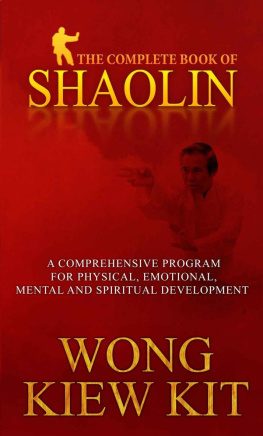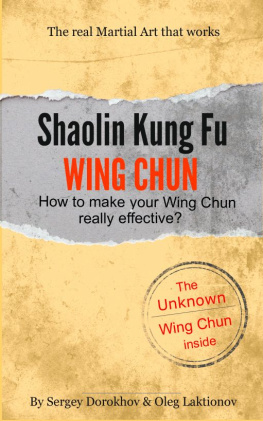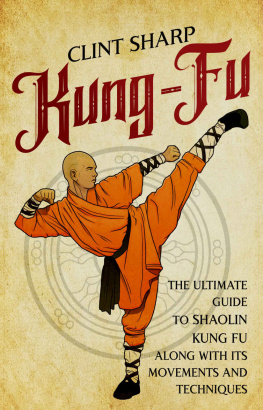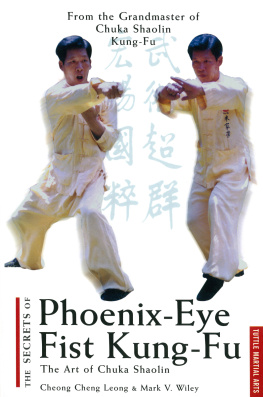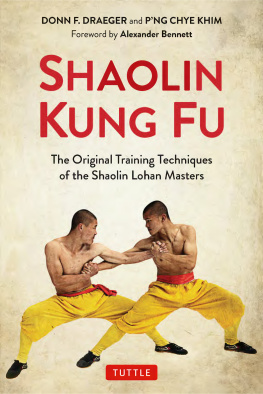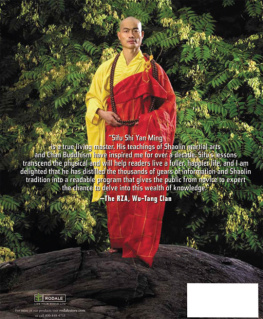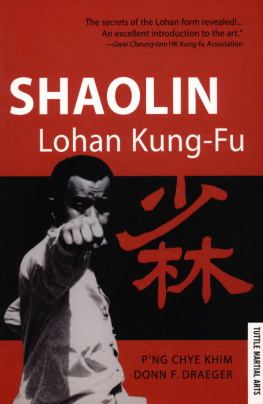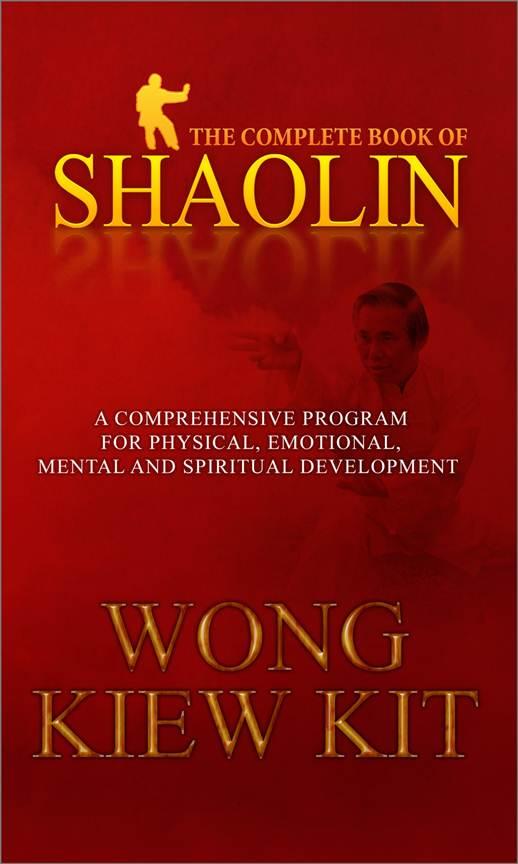
THE COMPLETE BOOK OF
SHAOLIN
A COMPREHENSIVE PROGRAM FOR PHYSICAL, EMOTIONAL, MENTAL AND SPIRITUAL DEVELOPMENT
WONG KIEW KIT
Author of the bestselling The Art of Chi Kung
COSMOS
WONG KIEW KIT 2012
Shaolin Wahnam Institute (Malaysia)
81, Taman Intan,
Lorong B/5,
08000 Sungai Petani,
Kedah, Malaysia.
Phone : +604 - 4222 - 353
Fax : +604 - 422 - 7812
Email : shaolin@pd.jaring.my
All Rights Reserved
The publication, either written or pictorial may not be reproduced, lent, rent, copied, translated or stored in any electronic or mechanical machines in a readable format without the written permission of the publisher.
Disclaimer
We caution all our readers to consult their primary healthcare provider or professional alternative healthcare practitioners as this publication should not be considered as medical advice to patients or readers. We encourage all our readers to consult and discuss both the advantages and disadvantages of alternative and complementary medicine, with their primary health care provider or professional alternative health care practitioners. By reading this publication, the reader agrees to the terms of this disclaimer and further waives any rights or claims he or she may have against the Publisher, Author and/or any other parties involved in the publication or the distribution of this publication.
ISBN 983-40879-1-8
By the same author
Complete Book of Zen
(Available in English, Spanish, Greek, Italian, Russian and Hebrew)
Art of Shaolin Kung Fu
(Available in English, Greek, Russian, Polish and Italian)
Complete Book of Tai Chi Chuan
(Available in English, Portuguese, Italian, Greek, Dutch, Russian and
Spanish)
Chi Kung for Health and Vitality
(Available in English, Polish and Portuguese)
Art of Chi Kung
(Available in English, Russian, German, Spanish and Greek)
Introduction to Shaolin Kung Fu
(Available in English)
Complete Book of Chinese Medicine
(Available in English and Spanish)
Complete Book of Shaolin
(Available in English)
Sukhavati: Western Paradise
(Available in English)
Master Answers Series: The Shaolin Arts
(Available in English)
THE AUTHOR
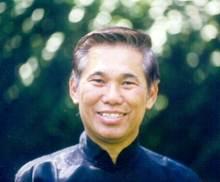
Wong Kiew Kit , popularly known as Sifu Wong, is the fourth generation successor of Venerable Jiang Nan from the famous Shaolin Monastery in China and Grandmaster of Shaolin Wahnam Institute of Kungfu and Qigong. He received the "Qigong Master of the Year" Award during the Second World Congress on Qigong held in San Francisco in 1997.
He is an internationally acclaimed author of books on the Shaolin arts and Buddhism including Introduction to Shaolin Kung Fu (1981), The Art of Qigong (1993), The Art of Shaolin Kung Fu (1996), The Complete Book of Tai Chi Chuan (1996), Chi Kung for Health and Vitality (1997), The Complete Book of Zen (1998), The Complete Book of Chinese Medicine (2002), The Complete Book of Shaolin (2002), Sukhavati: The Western Paradise (2002) and The Shaolin Arts (Master Answers) (2002).
Since 1987, Sifu Wong has spent more time teaching qigong than kungfu, because he feels that while kungfu serves as an interesting hobby, qigong serves an urgent public need, particularly in overcoming degenerative and psychiatric illnesses.
Sifu Wong is one of the few masters who have generously introduced the once secretive Shaolin Qigong to the public, and has helped many people to obtain relieve or overcome so-called "incurable" diseases like hypertension, asthma, rheumatism, arthritis, diabetes, migraine, gastritis, gall stones, kidney failure, depression, anxiety and even cancer.
He stresses the Shaolin philosophy of sharing goodness with all humanity, and is now dedicated to spreading the wonders and benefits of the Shaolin arts to people all over the world irrespective of race, culture and religion.
Sifu Wongs website: www.shaolin.org
Introduction
If you think this is a book purely about a fighting art, you will be in for a pleasant surprise. Shaolin Kungfu, one of the most beautiful martial arts in the world is neither the only nor the best of the Shaolin arts, which range from poetry and medicine to Zen and Mahayana philosophy.
Wong Kiew Kit, a Shaolin grandmaster of over thirty years experience, gives a fascinating and in-depth explanation in a clear and enjoyable language. Martial artists will find amazing fighting techniques and methods for internal force training. Shaolin Chi Kung promotes not only health and vitality, but also provides hope for those suffering from so-called incurable diseases like hypertension diabetes, sexual inadequacy and even cancer. Meditation, the supreme Shaolin art trains the mind for more efficient daily work and play, and at the highest level, leads to spiritual fulfilment irrespective of race culture and religion.
In accordance with Shaolin philosophy the readers are urged not to accept these claims on faith nor on reputation but practice these arts that are systematically explained in the book, and evaluate the claims based on their experiences. True Shaolin disciples, the author says, do not tell lies.
1: A HEAVENLY VISION
(How Shaolin Monastery Got Its Name)
In heaven above there is Zhulin Monastery;
on earth below there is Shaolin Monastery.
The Legend of Shaolin
The Shaolin Monastery. The name itself spells magic to many people. Throughout the ages, it has been romantically linked to numerous sagas and parables involving great kungfu masters, spiritual teachers, generals, and emperors, as well as ordinary people. Poets sang odes to praise it, famous calligraphers engraved their writings in its many stone tablets, hostile armies razed the monastery to the ground, appreciative governments rebuilt it to greater glory, martial artists considered its fighting skills the pinnacle of achievements, and spiritualists regarded this sacred temple as fountain of inspiration, while its arts and philosophy have influenced and benefited millions of people in their daily lives.
Yet the Shaolin Monastery existed like a legend in the imagination of the populace well-known, highly-esteemed and fascinating, but mysterious and awe-inspiring, because since its founding in the Northern Wei Dynasty in the 6th century, rulers of all succeeding dynasties consecrated the Shaolin Monastery as the Temple of Imperial Worship, making it inaccessible to common people.
In 1928 the monastery suffered its third and most destructive fire in its long history; angry warlords burned the monastery for 45 days, resulting in the loss of invaluable treasure and property. This transformed the monastery into folklore. For the greater part of this century, many people wondered whether the temple was real or just a myth! Only recently, the Chinese government spent much money and effort to restore the monastery to its original form, and classified it as protected historical heritage, thus rekindling the concern for and excitement of the Shaolin tradition.
The Sacred Summit of Song Shan
The fabulous Shaolin Monastery is situated at the Central Mountains of Song Shan in the Henan Province of China. Song Shan consists of two major ranges: the Taishi Mountain in the east and the Shaoshi Mountain in the west. From afar, Song Shan looks like a pretty damsel having an afternoon nap in spring.
Song Shan itself is rich in legend and history. It was the tradition of Chinese emperors, known as Sons of Heaven, to ascend Sacred Summits to pray to Heaven. There are five Sacred Summits in China, located in the five strategic positions: east, west, south, north, and central; Song Shan is the Central Sacred Summit.
Next page
